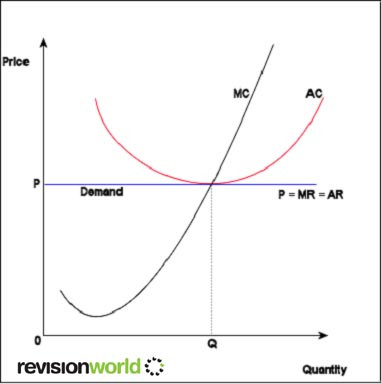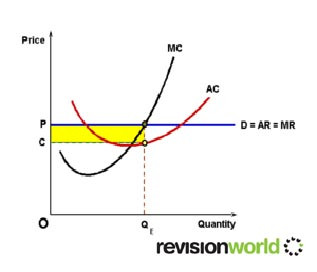Benefits of Competition
Short term
- Firms are encouraged to make cost savings by: Increasing productivity and Innovating
- This allows firms to cut the price of products
- Consumers benefit from lower prices, more choice and higher quality products
- Firms in perfectly competitive markets also compete on non price factors such as quality of service which provide benefits for the consumers
Long term
- Benefits relate to the efficient allocation of resources
Perfect Competition
Perfectly competitive markets have a large number of firms producing identical products. As the products are the same consumers do not display a preference for one firm over another.
There are no barriers to entry or exit so it is easy for firms to come in to or leave the market. All consumers have access to information on the firms and products in the market place and they have good knowledge of the products.
Each producer is responsible for a very small % of the total quantity supplied in the market. Potential profits for firms in this type of market are low.
Perfect Competition - Long Run
- This is the long run equilibrium position PQ
- The firm is making a normal profit at this point

Perfect Competition - Short Run
- In the short run equilibrium price is determined by the interaction of the market demand and market supply curves
- The equilibrium price is the market clearing price and this is used by all firms as they are price takers
- As market price is the same regardless of quantity AR = MR
- In the short run if the price is above costs a business is able to make supernormal profits
Perfect Competition Graph
- The yellow area shows profits earned by the firm
- The firm will be receiving the supernormal profits due to their cost curve
- Due to perfect knowledge in the market any differences in costs will be eradicated in the long term as firms know about each others behaviour

Competition and the Efficient Allocation Of Resources
Given the following assumptions:
- Many small firms
- Complete freedom of entry / exit Many individual buyers
- Products are perfect substitutes
- Perfect knowledge
- Absence of externalities (private costs and benefits are equal to social costs and benefits)
Perfect competition results in the efficient allocation of resources
Perfect Competition & Efficiency
The model of perfect competition achieves efficiency in three ways:
Allocative efficiency:
- Price = MC and therefore consumer and producer surpluses are maximised
Productive efficiency:
- In the long run in perfect competition equilibrium output is produced where average costs are at their lowest point
Dynamic efficiency:
- As products are all virtually the same one business is unable to differentiate their product and gain monopoly power
Perfect Competition and Assumptions
In the real world the conditions of perfect competition rarely exist. Most markets have some barriers to entry / exit especially barriers to contestability.
In the majority of markets some consumers purchase a greater % of output than others giving themselves increased power. Most consumers face imperfect information and therefore may not make informed choices about products.
Consumers are susceptible to other influences when making their purchasing decisions such as advertising and promotional tools. Most products produce some externalities in production and consumption.
Most products are not exactly the same – products tend to be differentiated and therefore consumers tend to prefer certain products to others
Perfect Competition - A Reality?
One of the few markets that nears perfect competition is the currency market because:
- All goods in the market are perfect substitutes
- There are a large amount of firms selling currency
- There are a large amount of consumers
- There is good quality information and most buyers / sellers have a high degree of expertise
However this is still not perfect as there are :
- Barriers to entry
- Government influences on the market
Dynamics of Competition and Competitive Market Processes
In addition to efficiency there are a number of benefits that in the short and long run can lead to a number of benefits. In perfectly competitive markets firms need to keep their costs to a minimum this results in reduced wastage of resources.
Competition in the domestic market increases international competitiveness resulting in gains from trade
